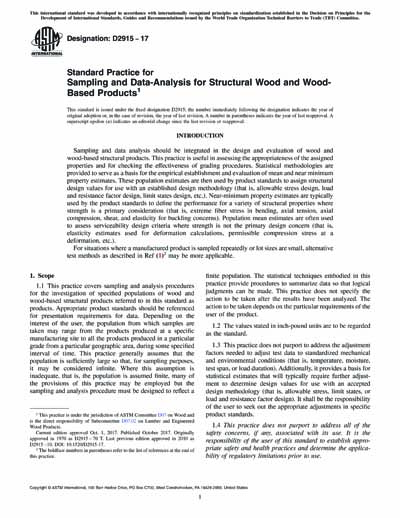Historical
ASTM D2915-17
Standard Practice for Sampling and Data-Analysis for Structural Wood and Wood-Based Products
1.1 This practice covers sampling and analysis procedures for the investigation of specified populations of wood and wood-based structural products referred to in this standard as products. Appropriate product standards should be referenced for presentation requirements for data. Depending on the interest of the user, the population from which samples are taken may range from the products produced at a specific manufacturing site to all the products produced in a particular grade from a particular geographic area, during some specified interval of time. This practice generally assumes that the population is sufficiently large so that, for sampling purposes, it may be considered infinite. Where this assumption is inadequate, that is, the population is assumed finite, many of the provisions of this practice may be employed but the sampling and analysis procedure must be designed to reflect a finite population. The statistical techniques embodied in this practice provide procedures to summarize data so that logical judgments can be made. This practice does not specify the action to be taken after the results have been analyzed. The action to be taken depends on the particular requirements of the user of the product.
1.2 The values stated in inch-pound units are to be regarded as the standard.
1.3 This practice does not purport to address the adjustment factors needed to adjust test data to standardized mechanical and environmental conditions (that is, temperature, moisture, test span, or load duration). Additionally, it provides a basis for statistical estimates that will typically require further adjustment to determine design values for use with an accepted design methodology (that is, allowable stress, limit states, or load and resistance factor design). It shall be the responsibility of the user to seek out the appropriate adjustments in specific product standards.
1.4 This practice does not purport to address all of the safety concerns, if any, associated with its use. It is the responsibility of the user of this standard to establish appropriate safety and health practices and determine the applicability of regulatory limitations prior to use.
1.5 This international standard was developed in accordance with internationally recognized principles on standardization established in the Decision on Principles for the Development of International Standards, Guides and Recommendations issued by the World Trade Organization Technical Barriers to Trade (TBT) Committee.
ASTM International [astm]

